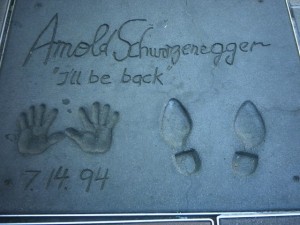
Schwarzenegger’s hand- and footprint proto-selfies in front of Grauman’s Chinese Theater (image via Wikipedia)
LOS ANGELES — What is a selfie but a momentary image of oneself captured in social-network time? The selfie can be shot anytime, anywhere, and uploaded instants later. Take Ashley Keast, a burglar in the UK who, after robbing a home, placed his SIM card inside a stolen mobile phone, took a selfie, and accidentally sent the image using WhatsApp. Much like the young Swedish girls who snapped a selfie before robbing a fast-food restaurant, this burglar wanted to capture himself in this act of breaking and entering. Photographic evidence that says ‘I was here, I exist’ is always useful to the police.
Selfies can be used to the advantage of law-abiding citizens, too. Andrew Jarvis, an architect who works in both New York and Philadelphia, realized that he could avoid New York taxes if he lived there fewer than 182 days per year. To insure that the IRS believed him, he took selfies to document his location; often times he holds up a newspaper to prove what day it is. This is an interesting idea, although it would be easy to just get a bunch of newspapers and take photos in batches per season. But Jarvis’s selfies are quite convincing and come across as honest — and it’s also worth noting that he never uses the long-arm technique or a smartphone. Instead, he uses the good old self-timer on a digital camera. All of his photographs are available on Instagram.
Read the full story on Hyperallergic: http://hyperallergic.com/116198/not-your-average-selfie/



